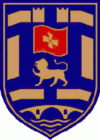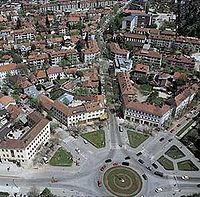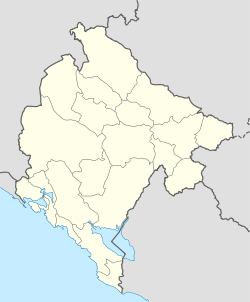- Nikšić
-
Nikšić
Никшић
Coat of armsLocation of Nikšić Coordinates: 42°46′48″N 18°56′24″E / 42.78°N 18.94°ECoordinates: 42°46′48″N 18°56′24″E / 42.78°N 18.94°E Country  Montenegro
MontenegroFounded 4th century as Anagastum Settlements 110 Government – Mayor Nebojša Radojičić (DPS) – Ruling party DPS - SDP Area – Total 2,065 km2 (797.3 sq mi) Population (2011 census) – Total 57,278 – Density 37/km2 (95.8/sq mi) – Municipality 72,824 Time zone CET (UTC+1) – Summer (DST) CEST (UTC+2) Postal code 81400 Area code +382 40 Car plates NK ISO 3166-2 code ME-12 Website http://www.niksic.me/ Nikšić (Montenegrin: Nikšić, Никшић, pronounced [nîkʃit͡ɕ]) is a city in Montenegro (42°47′N 18°56′E / 42.78°N 18.94°E). In 2003 the city had a total population about 75,000.
Nikšić is located in Nikšić plain,[1] at the foot of Mount Trebjesa. It is the center of the municipality (Population of 75,282), which is the largest in Montenegro by area. Nikšić is the second largest city in Montenegro, after Podgorica, and is an important industrial, cultural, and educational center.
Contents
History
The first settlement in the area of modern-day Nikšić is thought to be formed in the 4th century, as a Roman military camp. The camp was probably founded on the site of the previous Illyrian tribal settlement. The camp and the settlement were known as Anagastum, which was later transliterated as Onogošt, which was the name of the city throughout the Middle Ages.
The settlement got its Slavic name of Onogošt during the migrations of the Slavs into the area. During the early Slavic state of Duklja, Onogošt was mentioned as one of the župas (administrative divisions) within Podgorje area. Along with the rest of Duklja, Nikšić became a part of Rascia in 9th century. With the dissolution of Rascia, Nikšić came under the rule of Kingdom of Bosnia in 1373, and was under the rule of Kosača family of Herzegovina from 1448 until Herzegovina fell to the Ottomans.
Ottoman Empire took hold of Nikšić in 1455, and it stayed under control of the Turks for more than four hundred years, as a part of Herzegovina Province. During the later years of Ottoman occupation, Nikšić served as a significant fortified military stronghold. It was liberated by Montenegrins in 1877, under the command of Duke Mašo Vrbica. After the liberation, the small Ottoman hamlet began to transform into a modern urban settlement. The first urban plan was adopted in 1883, commissioned by King Nicholas, and designed by Croatian architect Josip Slade. Development of Nikšić is based on the guidelines of 1883 plan to this day. Simultaneously with urban development, cultural and economical expansion followed after inclusion of Nikšić into Montenegro.
Although the city was not devastated in World Wars as much as Podgorica, all development and growth were halted. After the city was liberated from German occupation in 1944, the most dynamic growth of Nikšić followed. The city population was increased tenfold, and Nikšić became the heart of Montenegrin industrial complex. During the SFRY era, the city flourished, as steel and iron works, bauxite mines, electricity production, brewery and wood processing industries were set up in and around the city.
However, as a mainly industrial city, Nikšić was hit hard during the severe economic stagnation and decline of the industries throughout Montenegro during the 1990s, with Yugoslav Wars raging in the region. Some of the industries recovered during the 2000s, and industry still makes up for the most economic activity in the city.
Geography
Nikšić is situated in north-central Montenegro. It is located at the centre of the spacious Nikšić field (Nikšićko polje), a karst plain with an area of 48 km², and an elevation of 640 m AMSL. The plain is surrounded by inhospitable rocky mountainous terrain, a typical landscape of western Montenegro. The city itself is located at the foot of the Trebjesa hill.
Zeta river originates in the Nikšić field, and flows near the city of Nikšić, before it becomes a subterranean river south of the city. The river caused frequent flooding of the plain, until the construction of Hydroelectric power plant Perućica in 1960. The construction of the power plant resulted in creation of three large artificial lakes near the city - Krupac Lake, Slano Lake and Vrtac Lake. Today, the lakes are a popular recreation and relaxation retreats for the citizens of Nikšić.
Climate
Climate of the Nikšić area has the characteristics of both Mediterranean climate and Continental climate. Average temperature for January is 1.3 °C (34.3 °F), while average temperature in July is 21.1 °C (70.0 °F). Average humidity amounts to 68,6%. Nikšić receives 2.245 hours of sunshine per year, with hot and dry summer, and rainy winter. On average, there are 19 days per year with snowfall.
Cityscape
Although Nikšić area has seen human settlements since antiquity, most of the modern Nikšić is a planned city. Very little remains of the Ottoman architectural heritage, despite the long presence of Ottoman Empire in the area. The city layout visible today still follows the 1883 urban plan commissioned by King Nicholas and designed by Croatian architect Josip Slade.
According to this plan, the streets of Nikšić radiate to the north and east from the central city square (today a roundabout), locally known as Skver. The radial streets are intersected by circumferential streets and avenues, thus creating a half-spider web-like street layout.
Layers of different architectural styles and urban patterns are evident along the radial network of streets. Thus, closest to the central roundabout is the historical core of Nikšić, formed after the liberation from Ottoman Empire, and serving as a nucleus for Slade's urban plan. This area, on the foot of Trebjesa Hill, is home to King Nicholas Palace, City Park, and King Nicholas Square, main city square located along the central Njegoševa Street. The area is composed of mostly single or two storey row housing with basic designs, an architecture typical for late 19th century and early 20th century Montenegro. The roundabout and the surrounding area is still the focal point of activities in the city, as bus and train stations, as well as commercial and civic services are located in the area.
Farther from the central roundabout, the historical core is encircled with a layer of mass residential blocks, built during the SFRY era. The building of the highrise residential blocks facilitated housing of the large population drawn to the city by rapid post-World War II industrialisation. The SFRY era apartment blocks are still home for the majority of residents of Nikšić.
Beyond the blocks, the city expanded in form of a suburban sprawl, that consists of detached housing. Close to the city blocks and major industrial areas, the lowrise single home suburbs are built with well executed urban plans, but farther away from the center, the city expanded in a chaotic and informal way. In addition, the rural areas south of Nikšić have merged with the city, so low density suburbs extend from the city in every direction, covering much of the Nikšić Field.
Culture
 King Nikola's palace in Nikšić
King Nikola's palace in Nikšić
Although mostly perceived as an industrial center, Nikšić is also a city of rich cultural heritage. The most significant cultural institution in the city is Centar Za Kulturu (Cultural Center), which incorporates the city's major public cultural establishments:
- Zavičajni Muzej (County Museum), situated in King Nicholas Palace, documents the historical development of the city.
- Nikšić art gallery
- Public library and Public archive
- Nikšić theater
- Zahumlje folk music society
- Stari Grad Anderva art society
The most significant cultural event in the city is Septembarski Dani Kulture (September days of Culture), that is one of the most recognizable cultural happenings in Montenegro. Other annual artistic events include Pjesnik na korzu (Poet on the promenade), Međunarodni festival glumca (International actors festival), Međunarodni festival kamerne muzike (International festival of chamber music), Međunarodni festival gitare (International guitar festival) and Lake Fest rock festival.
Nikšić is known for its distinctive cultural atmosphere and bohemian art scene, with poet Vitomir Nikolić and singer/songwriter Miladin Šobić as prominent representatives of the Nikšić bohemian spirit.
Media scene of Nikšić is mostly confined to public broadcasters TV Nikšić and Radio Nišić, and a number of commercial radio stations. Riječ and Luča magazines, published by Faculty of Philosophy, as well as Poznanstva children magazine, are also a part of Nikšić cultural scene.
Education
Nikšić is home to 40 educational institutions. Among those are 11 nurseries, 25 elementary schools of which one is elementary music school and 4 high schools, including the University of Montenegro:
- Faculty of Philosophy - a complex educational and scientific institution which organizes undergraduate, specialist and postgraduate studies as well as doctoral studies within its main activities. Three institutes operate within the faculty:
- Institute of philosophy and sociology
- Institute of language and literature and
- Institute of geography
- Faculty of sports and physical education
Sports
Nikšić is regarded as one of the centers of Montenegrin sport. The combat sports are particularly popular in Nikšić, with a strong tradition in judo, karate and boxing. Nikšić judokas have been exceptionally successful at international competitions.
Sutjeska football club is the pillar of the city soccer tradition. The club has risen to the Yugoslav First League during the SFRY era, and has played in the Montenegrin First League since 2006. City Stadium is the clubs home field. Čelik football club is a smaller club that competes in the Montenegrin Second League.
Other team sports, particularly handball and volleyball, are very popular in Nikšić.
Besides City Stadium, other significant sporting venue is the Nikšić Sports Center. This facility features a 3,000 seat indoor sports hall, olympic-size swimming pool, 6-lane bowling alley, sports shooting range, tennis and futsal courts, and various other facilities.
Vučje ski resort is 18 km away from the city center, making winter sports a popular recreation among the citizens of Nikšić.
Population
Nikšić is administrative centre of Nikšić municipality, which incorporates a densely populated fertile plain called "Župa", and has a population of 75,282 (2003. census). Nikšić itself has 58,212 citizens.
Population of Nikšić:
- March 3, 1981 - 50,399
- March 3, 1991 - 56,141
- November 1, 2003–58,212
Ethnic groups (1991 census):
- Montenegrins (88.17%)
- Serbs (5.71%)
- Muslims by nationality (2.03%)
- Roma (1.07%)
Ethnicity in 2003
Ethnicity Number Percentage Montenegrins 47,154 62.63% Serb 20,129 26.74% Muslims 695 0.92% Total 75,282 100% Economy
Nikšić is, alongside Podgorica, one of the biggest industrial centres of Montenegro. A Steel mill (Nikšićka Željezara), bauxite mine, Trebjesa brewery (Nikšićka Pivara), and many more are concentrated in this city.
These big industries have struggled to survive the collapse of the socialist economy, but have since recovered. The process of privatization is either finished or still in progress for some of these industries.
Today those industry giants cannot employ as many workers as they could back in the days of Socialist Federal Republic of Yugoslavia, and the economy of Nikšić is slowly transforming into one that is more service oriented. In 1981 Niksic's GDP per capita was 91% of the Yugoslav average. [2]
Transport
 Main roundabout in Nikšić
Main roundabout in Nikšić
Nikšić's main road connection to the rest of Montenegro is E762 motorway, which connects Nikšić with Podgorica. This is 55 km (34 mi) long and relatively new two-laned road. Nikšić is also a hub for road traffic towards Bosnia and Herzegovina, as it is connected with Foča to the north and Trebinje to the south-east. There is also a detour from Nikšić - Trebinje road which goes to Risan in Bay of Kotor, and that is the shortest road connection with Montenegrin coast. Nikšić is also connected with Žabljak through Šavnik.
Nikšić has rail link with Podgorica, but until now it has been used mainly to transport bauxite from Nikšić bauxite mine to Podgorica Aluminium Plant. Railway is currently under reconstruction and electrification, and will be open for passenger use sometime in 2009.
Podgorica Airport is some 70 km (43 mi) away from Nikšić, and has regular flights to Belgrade, Sarajevo, Budapest, Zurich, Frankfurt, Ljubljana, Paris, Rome and Vienna.
Notable individuals from Nikšić area
- Mirko Vučinić, footballer
- Glomazić Zoran, basketball coach
- Ilija Šobajić, painter
- Branko Babović, actor
- Petar Banićević, actor
- Dragomir Bečanović, judoist
- Andrija Delibašić, footballer
- Milo Đukanović, politician
- Miodrag "Skale" Gvozdenović, volleyball player
- Goran Jeretin, basketball player
- Miodrag Krivokapić, footballer
- Andrija Milošević, actor
- Alen Muratović, handball player
- Živko Nikolić, movie director
- Dragan "Bato" Ognjenović, karate and full-contact
- Krsto Papić, Croatian film director, born in Vučji do near Nikšić
- Željko Petrović, footballer
- Nemanja Andrijašević, MOTO GP driver, Ghostrider
- Rođa Raičević, singer
- Zdravko Radulović, basketball player
- Miladin Šobić, musician
- Žarko Varajić, basketball player
- Luka Vučinić, writer
- Radivoje "Mušo" Vuković, alpinist and lifesaver
- Rajko Žižić, basketball player
- Ivan Nikčević, handball player
- Miljan Zeković, footballer
- Nikola Karović, singer
- Freaky Funk, Dee Jay
References
- ^ "niksic". travelsradiate: travelsradiate.com. http://www.travelsradiate.com/europe/republic-of-montenegro/opstina-kotor/niksic/3194494. Retrieved 2010-11-19.
- ^ Radovinović, Radovan; Bertić, Ivan, eds (1984) (in Croatian). Atlas svijeta: Novi pogled na Zemlju (3rd ed.). Zagreb: Sveučilišna naklada Liber.
External links
- Official site (Montenegrin and English)
- Official site (Montenegrin and English)
- Visit-Montenegro.com
- Photo-Montenegro.com
- Faculty of Philosophy
Categories:- Populated places in Montenegro
- Municipalities of Montenegro
- Nikšić
Wikimedia Foundation. 2010.


